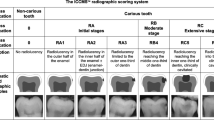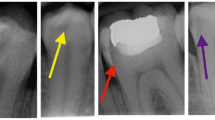Abstract
The study aimed to evaluate the impact of image size, area of detection (IoU) thresholds and confidence thresholds on the performance of the YOLO models in the detection of dental caries in bitewing radiographs. A total of 2575 bitewing radiographs were annotated with seven classes according to the ICCMS™ radiographic scoring system. YOLOv3 and YOLOv7 models were employed with different configurations, and their performances were evaluated based on precision, recall, F1-score and mean average precision (mAP). Results showed that YOLOv7 with 640 × 640 pixel images exhibited significantly superior performance compared to YOLOv3 in terms of precision (0.557 vs. 0.268), F1-score (0.555 vs. 0.375) and mAP (0.562 vs. 0.458), while the recall was significantly lower (0.552 vs. 0.697). The following experiment found that the overall mAPs did not significantly differ between 640 × 640 pixel and 1280 × 1280 pixel images, for YOLOv7 with an IoU of 50% and a confidence threshold of 0.001 (p = 0.866). The last experiment revealed that the precision significantly increased from 0.570 to 0.593 for YOLOv7 with an IoU of 75% and a confidence threshold of 0.5, but the mean-recall significantly decreased and led to lower mAPs in both IoUs. In conclusion, YOLOv7 outperformed YOLOv3 in caries detection and increasing the image size did not enhance the model’s performance. Elevating the IoU from 50% to 75% and confidence threshold from 0.001 to 0.5 led to a reduction of the model’s performance, while simultaneously improving precision and reducing recall (minimizing false positives and negatives) for carious lesion detection in bitewing radiographs.






Similar content being viewed by others
References
Righolt AJ, Jevdjevic M, Marcenes W, Listl S. Global-, Regional-, and Country-Level Economic Impacts of Dental Diseases in 2015. J Dent Res, 97(5):501-507, 2018.
Nascimento MM, Bader JD, Qvist V, Litaker MS, Williams OD, Rindal DB, et al. Concordance between preoperative and postoperative assessments of primary caries lesion depth: results from the Dental PBRN. Oper Dent, 35(4):389-396, 2010.
Menem R, Barngkgei I, Beiruti N, Al Haffar I, Joury E. The diagnostic accuracy of a laser fluorescence device and digital radiography in detecting approximal caries lesions in posterior permanent teeth: an in vivo study. Lasers Med Sci, 32:621-628, 2017.
Cantu AG, Gehrung S, Krois J, Chaurasia A, Rossi JG, Gaudin R, et al. Detecting caries lesions of different radiographic extension on bitewings using deep learning. J Dent, 100:103425, 2020.
Mertens S, Krois J, Cantu AG, Arsiwala LT, Schwendicke F. Artificial intelligence for caries detection: Randomized trial. J Dent, 115:103849, 2021.
Lee Y. Diagnosis and prevention strategies for dental caries. J Lifestyle Med, 3(2):107, 2013.
Redmon J, Divvala S, Girshick R, Farhadi A, editors. You only look once: Unified, real-time object detection. Proceedings of the IEEE conference on computer vision and pattern recognition, 779–788, 2016.
Thanh MTG, Van Toan N, Ngoc VTN, Tra NT, Giap CN, Nguyen DM. Deep Learning Application in Dental Caries Detection Using Intraoral Photos Taken by Smartphones. Appl Sci, 12(11):5504, 2022.
Sonavane A, Kohar R. Dental Cavity Detection Using YOLO. Proceedings of Data Analytics and Management: Springer, 141–152, 2022.
Bayraktar Y, Ayan E. Diagnosis of interproximal caries lesions with deep convolutional neural network in digital bitewing radiographs. Clin Oral Invest, 26(1):623-632, 2022.
Pitts NB, Ismail AI, Martignon S, Ekstrand K, Douglas GV, Longbottom C, et al. ICCMS™ guide for practitioners and educators, 2014.
Panyarak W, Suttapak W, Wantanajittikul K, Charuakkra A, Prapayasatok S. Assessment of YOLOv3 for caries detection in bitewing radiographs based on the ICCMS™ radiographic scoring system. Clin Oral Invest, 27(4):1731-1742, 2023.
Wang CY, Bochkovskiy A, Liao HYM. YOLOv7: Trainable bag-of-freebies sets new state-of-the-art for real-time object detectors. In Proceedings of the IEEE/CVF Conference on Computer Vision and Pattern Recognition, 7464–7475, 2022.
Zhang Z, He T, Zhang H, Zhang Z, Xie J, Li M. Bag of freebies for training object detection neural networks. arXiv preprint arXiv:1902.04103, 2019.
Hossin M, Sulaiman MN. A review on evaluation metrics for data classification evaluations. Int J Data Min Knowl Manag Process, 5(2):1, 2015.
Padilla R, Passos WL, Dias TL, Netto SL, Da Silva EA. A comparative analysis of object detection metrics with a companion open-source toolkit. Electronics, 10(3):279, 2021.
Manning CD. Introduction to information retrieval: Syngress Publishing; 2008.
Selvaraju RR, Cogswell M, Das A, Vedantam R, Parikh D, Batra D, editors. Grad-cam: Visual explanations from deep networks via gradient-based localization. Proceedings of the IEEE international conference on computer vision, 618–626, 2017.
Padilla R, Netto SL, Da Silva EA, editors. A survey on performance metrics for object-detection algorithms. 2020 international conference on systems, signals and image processing (IWSSIP). IEEE, 237–242, 2020.
Wang C-Y, Bochkovskiy A, Liao H-YM, editors. Scaled-yolov4: Scaling cross stage partial network. Proceedings of the IEEE/cvf conference on computer vision and pattern recognition, 13029–13038, 2021.
Ren S, He K, Girshick R, Sun J. Faster r-cnn: Towards real-time object detection with region proposal networks. Adv Neural Inf Process Syst, 9199(10.5555):2969239–2969250, 2015.
Oka S, Nozaki K, Hayashi M. An efficient annotation method for image recognition of dental instruments. Sci Rep, 13(1):169, 2023.
Wenkel S, Alhazmi K, Liiv T, Alrshoud S, Simon M. Confidence score: The forgotten dimension of object detection performance evaluation. Sensors, 21(13):4350, 2021.
Jin G, Taniguchi R-I, Qu F. Auxiliary detection head for one-stage object detection. IEEE Access, 8:85740-85749, 2020.
Author information
Authors and Affiliations
Contributions
All authors contributed to the study conception and design. Material preparation and data collection were performed by Wannakamon Panyarak. The image annotation was performed by Wannakamon Panyarak, Arnon Charuakkra and Sangsom Prapayasatok. Deep learning implementation and analysis were performed by Wattanapong Suttapak and Kittichai Wantanajittikul. The first draft of the manuscript was written by Wannakamon Panyarak and all authors commented on previous versions of the manuscript. All authors read and approved the final manuscript.
Corresponding author
Ethics declarations
Conflict of Interest
The authors declare no competing interests.
Additional information
Publisher's Note
Springer Nature remains neutral with regard to jurisdictional claims in published maps and institutional affiliations.
Appendix
Appendix
The results, presented in Fig. 7, showed that the precision of YOLOv7_640 was significantly lower than that of YOLOv7_1280 in classes RA1, RA2 and RA6. Additionally, its recall was significantly lower in classes RA1, RA3, RB4 and RC5, resulting in a lower F1-score in these classes.
When the IoU was increased to 75% (IoU75) and other hyperparameters were unchanged, the results were still significantly different between the two image sizes. The precision of YOLOv7_640 was still lower than that of YOLOv7_1280 in classes RA1, RA2, and RA6, and its recall was lower in most classes except for RA3 and RC6. This led to a lower F1-score in all classes, except for class RC6, as shown in Fig. 8.
The precision-recall curves of the YOLOv7 model at different IoU thresholds (50% and 75%) using a confidence threshold of 0.5 are shown in Fig. 9. The results demonstrate significant differences in the performance of class 0 and class RC6. Notably, the precision-recall curves associated with IoU75 exhibit significantly lower values compared to IoU50, leading to a decrease in the mAP for these classes.
Presents scattered plots illustrating the precision, recall and F1-score of the YOLOv7 models under the IoU50 and confidence threshold of 0.001. Additionally, the performance plots for both YOLOv7_640 and YOLOv7_1280, corresponding to input bitewing radiographs of 640 × 640 and 1280 × 1280 pixels, respectively, are shown. These evaluations are specifically conducted for caries detection, utilizing the ICCMS™ radiographic scoring system. In the plots, significantly higher values of YOLOv7_1280 are denoted by an asterisk (*), while significantly lower values are indicated by the hash symbol (#). The confidence thresholds range from 0 to 1.0, allowing for a comprehensive analysis of the model's performance
Illustrates scatter plots showcasing the precision, recall and F1-score of YOLOv7 models, considering an IoU threshold of 75% (IoU75) and a confidence threshold of 0.001. Additionally, the performance plots, encompassing confidence thresholds ranging from 0 to 1.0, are presented for both input bitewing radiographs of 640 × 640 (YOLOv7_640) and 1280 × 1280 (YOLOv7_1280) pixels, specifically for caries detection using the ICCMS™ radiographic scoring system. In the figure, an asterisk (*) denotes significantly higher values observed for YOLOv7_1280, while a hash symbol (#) indicates significantly lower values observed for YOLOv7_1280
Illustrates the precision-recall (PR) curves of the YOLOv7 model under two different Intersection over Union (IoU) thresholds, namely 50% (IoU50) and 75% (IoU75), while utilizing a confidence threshold of 0.5. The analysis reveals significant differences between these two IoUs in the performance of class 0 and class RC6. Specifically, the PR curves associated with IoU75 exhibit significantly lower values, leading to a reduced mean average precision (mAP)
Rights and permissions
Springer Nature or its licensor (e.g. a society or other partner) holds exclusive rights to this article under a publishing agreement with the author(s) or other rightsholder(s); author self-archiving of the accepted manuscript version of this article is solely governed by the terms of such publishing agreement and applicable law.
About this article
Cite this article
Panyarak, W., Wantanajittikul, K., Charuakkra, A. et al. Enhancing Caries Detection in Bitewing Radiographs Using YOLOv7. J Digit Imaging 36, 2635–2647 (2023). https://doi.org/10.1007/s10278-023-00871-4
Received:
Revised:
Accepted:
Published:
Issue Date:
DOI: https://doi.org/10.1007/s10278-023-00871-4







